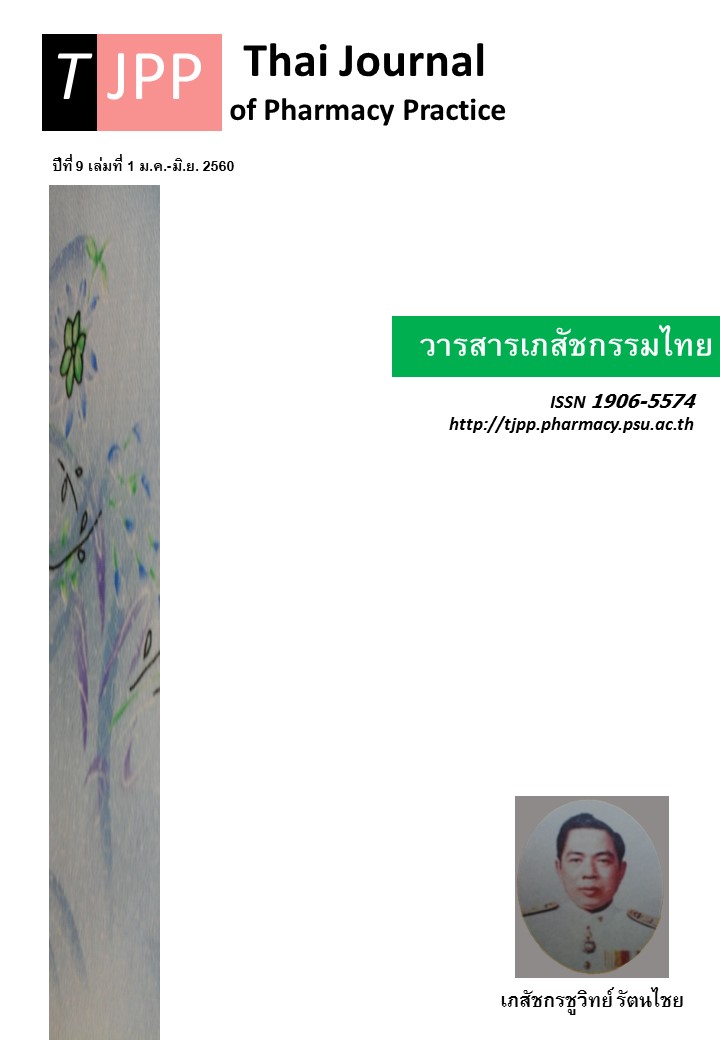ปัญหาด้านยาในผู้ป่วยโรคเรื้อรังระหว่างการเยี่ยมบ้านโดยเภสัชกร ในทีมหมอครอบครัวของเครือข่ายสุขภาพพรหมคีรี
Main Article Content
บทคัดย่อ
วัตถุประสงค์: เพื่อค้นหาปัญหาด้านยาในผู้ป่วยเรื้อรังของเภสัชกรในทีมหมอครอบครัว โดยการเยี่ยมบ้านกับโรงพยาบาลพรหมคีรี วิธีการ: ตัวอย่าง คือ ผู้ป่วยโรคเรื้อรังที่ถูกคัดเลือกจากโรงพยาบาลพรหมคีรีในปีงบประมาณ 2558 ให้ได้รับการเยี่ยมบ้านโดยทีมสหวิชาชีพ การเยี่ยมบ้านยึดหลักการดูแลผู้ป่วยแบบองค์รวมและตามแนวทาง INHOMESSS (immobility, nutrition, home environment, other people, medication, examination, safety, spiritual health และ service) เพื่อดูแลผู้ป่วยทั้งทางกาย จิต สังคม และสิ่งแวดล้อม เภสัชกรค้นหาปัญหาด้านยาโดยการสัมภาษณ์ผู้ป่วยและผู้ดูแล ตรวจสอบประวัติการรักษาจากฐานข้อมูลของโรงพยาบาล ตรวจสอบรายการยาที่ผู้ป่วยใช้ สังเกตการจัดยา-การเก็บยา การตรวจร่างกายเบื้องต้นเพื่อประเมินผลการรักษาด้วยยา การค้นหาอาการไม่พึงประสงค์จากการใช้ยา และการตรวจสอบการปนเปื้อนของสเตียรอยด์ในสมุนไพรหรือผลิตภัณฑ์สุขภาพที่สงสัยด้วยชุดทดสอบสเตียรอยด์ เภสัชกรบันทึกข้อมูลปัญหาด้านยาที่พบและวิธีการแก้ไขปัญหา การแบ่งประเภทปัญหาด้านยาใช้นิยาม ของ Hepler และ Strand ผลการวิจัย: ผู้ป่วยที่ได้รับการเยี่ยมบ้านทั้งหมด 229 คน ส่วนใหญ่เป็นเพศหญิง (ร้อยละ 76.53) อายุเฉลี่ย 72.58+10.21 ปี โรคเรื้อรัง 3 อันดับแรกได้แก่ เบาหวาน (ร้อยละ 42.79) ความดันโลหิตสูง (ร้อยละ 39.74) และโรคระบบหัวใจและหลอดเลือด (ร้อยละ 38.43) ผู้ป่วยได้รับการเยี่ยมบ้านเฉลี่ยคนละ 2.05+062 ครั้ง (พิสัย 1-3) ในรอบ 12 เดือน เภสัชกรค้นพบปัญหาด้านยาในผู้ป่วย 74 คน ปัญหาด้านยาที่พบมากที่สุด 4 อันดับแรก คือ ผู้ป่วยไม่ได้รับยาที่ควรจะได้รับ (ร้อยละ 31.08 ของปัญหาด้านยาที่พบทั้งหมด) ผู้ป่วยได้รับยาถูกต้อง แต่ขนาดน้อยเกินไป (ร้อยละ 28.38 ของปัญหาด้านยาที่พบทั้งหมด) ผู้ป่วยได้รับยาถูกต้องแต่ขนาดมากเกินไป (ร้อยละ 18.92 ของปัญหาด้านยาที่พบทั้งหมด) และผู้ป่วยได้รับยาที่ไม่มีข้อบ่งใช้ทางวิชาการ (ร้อยละ 10.81 ของปัญหาด้านยาที่พบทั้งหมด) ปัญหาด้านยาที่พบได้รับการแก้ไขในผู้ป่วยทุกราย สรุป: เภสัชกรมีบทบาทของสำคัญในทีมหมอครอบครัว โดยเป็นผู้จัดการแก้ปัญหาด้านยาของผู้ป่วยโรคเรื้อรังได้ จึงเป็นการช่วยเพิ่มศักยภาพของทีมในการดูแลผู้ป่วย และส่งผลที่ดีต่อการรักษา
Article Details
ผลการวิจัยและความคิดเห็นที่ปรากฏในบทความถือเป็นความคิดเห็นและอยู่ในความรับผิดชอบของผู้นิพนธ์ มิใช่ความเห็นหรือความรับผิดชอบของกองบรรณาธิการ หรือคณะเภสัชศาสตร์ มหาวิทยาลัยสงขลานครินทร์ ทั้งนี้ไม่รวมความผิดพลาดอันเกิดจากการพิมพ์ บทความที่ได้รับการเผยแพร่โดยวารสารเภสัชกรรมไทยถือเป็นสิทธิ์ของวารสารฯ
เอกสารอ้างอิง
2. Pothisat S, Couny N, Udomchairat R, Prechachaiwit P, Konlaeard S, Miratanaprat S, at al. Literature review: the current situation and care model of non-communicable disease. Nonthaburi: Institute of Medical Research and Technology Assessment, 2014.
3. Suwanwela NC. Stroke epidemiology in Thailand. J Stroke 2014; 16: 1-7.
4. Ministry of Public Health. Development plan for public health service system (service plan). Nonthaburi: Ministry of Public Health; 2012.
5. Leesathapornwongsa P. Action plan of role of primary care pharmacy in universal coverage system [online]. 2011. [cited Jan 5, 2016]. Available from: thaihp.org/index2.php?option=show file&tbl=home&id=697.
6. Primary Care Pharmacy Working Group. Handbook for pharmacists working in primary care units. Bangkok: Office of Health Consumer Protection Plan, 2011.
7. Department of Pharmacy and Health Consumer Protection, Kranuan Crown Prince Hospital. Report of drug related problems in patients with chronic diseases. Khonkaen: Kranuan Crown Prince Hospital; 2010.
8. Peterson GM, Fitzmaurice KD, Naunton M, Vial JH, Stewart k. Impact of pharmacist-conducted home visits on the outcomes of lipid-lowering drug therapy. J Clin Pharm Ther 2005; 29: 23-30.
9. Nisittra P. Effects of discharge counseling and home-based interventions provided by pharmacist among elderly patients [dissertation]. Khon kaen: Khon kaen University; 2007.
10. Thaungsuwan W, Jedsadayanmata A. Effect of pharmacist participation in multidisciplinary team for home visit on blood pressure and drug adherence of stroke
patients. Thai Journal of Pharmacy Practice 2016; 8: 48-57.
11. Maneerat M, Waleekhachonloet O, Phumart P, Sangasri P. Effect of home health care by pharmacy students on knowledge, compliance and wasted drug problems in households. Thai Journal of Pharmacy Practice 2010; 2: 24-34.
12. Tunpichart S, Sakulbumrungsil R, Somrongthong R, Hongsamoot D. Chronic care model for diabeticst by pharmacist home health in Bankok metropolitan: a community based study. Int J Med Med Sci 2012; 4: 90-6.
13. Ningsanon T. Monthakarnkul P, Wanakmanee U, Suansanea T, Chatuporn T. Textbook of family pharmacist. Bangkok: The Association of Hospital Pharmacy (Thailand); 2014.
14. Unwin BK, Jerant AF. The home visit. Am Fam Physician 1999; 1481-8.
15. Hepler CD. Strand LM. Opportunities and responsibilities in pharmaceutical care. Am J Hosp Pharm 1990; 47:533-43.
16. Rachaniyom S, Saramunee K. Family pharmacist ’s management of drug related problem for chronic diseases at patient’s in home, Kranuan district health network. Thai Journal of Pharmacy Practice 2016; 8: 169-81.
17. Chayanattapong P. Stories from the communities (hope of those with one foot in the grave). Clinic 2015; 31: 761-5.
18. Chayanattapong P. Stories from the communities (may not be a strong enough drug). Clinic 2015; 31: 1111-4.
19. Chayanattapong P. Stories from the communities (three lives-relationship in the circle of sickness). Clinic 2015; 31: 861-4.
20. Chayanattapong P. Stories from the communities (Pla’s end of life). Clinic 2015; 31: 1339-43.
21. Ensing HT, Koste ES, Stuijt CCM, van Dooren AA, Bouvy ML. Bridging the gap between hospital and primary care: the pharmacist home visit. Int J Clin Pharm 2015;
37: 430-4.
22. Weerawattanachai C. Factors affecting drug related problems in diabetic inpatients at Rajavithi hospital [master thesis]. Bangkok: Chulalongkorn University, 2002.
23. Hajjar ER, Cafiero AC, Hanlon JT. Polypharmacy in elderly patients. Am J Geriatr Pharmacother 2007; 5: 345-51.
24. Fiβ T, Meinke–Franze C, van den Berg N, Hoffmann W. Effects of a three party healthcare network on the incidence levels of drug related problems. Int J Clin Pharm 2013; 35:763-71.


